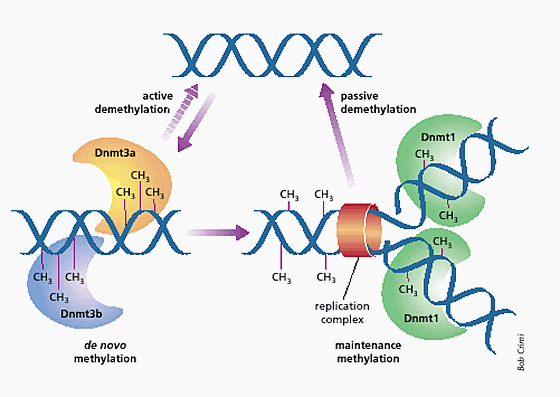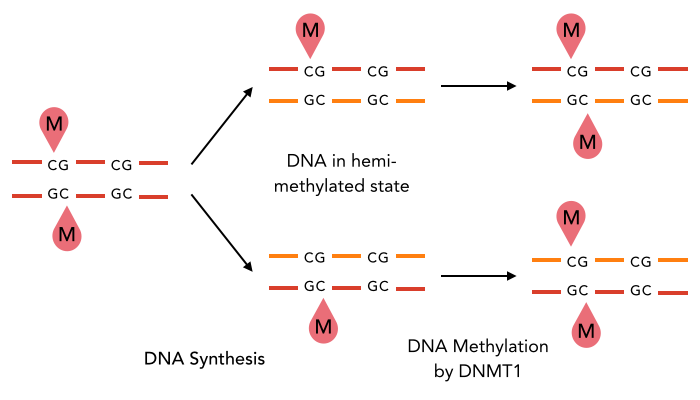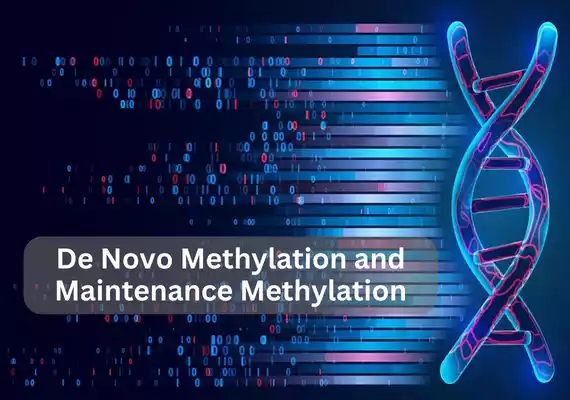Introduction of De Novo Methylation and Maintenance Methylation
De Novo Methylation and Maintenance Methylation are essential processes that ensure the appropriate regulation of genes and maintain genome integrity.
DNA methylation, an essential epigenetic modification, involves the addition of a methyl group to the DNA molecule, typically at cytosine residues in CpG dinucleotides. Two fundamental processes govern this modification.
De novo methylation and maintenance methylation. De novo methylation introduces new methylation marks on previously unmethylated CpG sites, shaping the epigenetic landscape during development and in response to environmental cues.
It lays down the primary methylation patterns, especially during embryogenesis. On the other hand, maintenance methylation ensures that these methylation patterns are faithfully replicated during DNA replication.
As cells divide, this process conserves the established methylation signatures from the parent strand to the daughter strand, ensuring epigenetic memory and stability across cellular generations.
Together, these processes orchestrate the intricate balance of dynamic and stable epigenetic modifications, playing crucial roles in gene regulation, cellular differentiation, and genome stability.
Definition of De Novo Methylation
De novo methylation refers to the process by which previously unmethylated regions of DNA acquire new methyl groups. This epigenetic modification primarily targets the 5′ position of cytosine residues within CpG dinucleotides in mammals.
The primary enzymes mediating de novo methylation are DNMT3a and DNMT3b. Unlike maintenance methylation, which preserves established methylation patterns, de novo methylation introduces entirely new patterns.

This process is pivotal during embryonic development, where global DNA demethylation is followed by selective remethylation to establish cell-specific gene expression patterns.
De novo methylation is instrumental in gene silencing, especially in genes that should not be expressed in specific cell types or developmental stages. Furthermore, it plays a critical role in silencing transposable elements, ensuring genome stability, and in processes such as X-chromosome inactivation in females.
Aberrant de novo methylation can have significant implications, such as unwarranted gene silencing, which, in certain cases, can lead to diseases like cancer.
Definition of Maintenance Methylation
Maintenance methylation is the epigenetic process that ensures the preservation of existing DNA methylation patterns after DNA replication. When DNA replicates, the newly synthesized daughter strand is initially unmethylated.
Maintenance methylation recognizes these hemi-methylated DNA sites, where one strand is methylated, and the complementary strand is not. The enzyme primarily responsible for this process is DNMT1.

By adding a methyl group to the new DNA strand, DNMT1 ensures that methylation patterns from the parent strand are accurately copied to the daughter strand. This process is vital for maintaining stable gene repression across cell divisions, ensuring that genes once silenced remain so in the daughter cells.
It preserves cellular identity by maintaining cell-type-specific methylation signatures, which are crucial for cell differentiation and function. Maintenance methylation also safeguards genome stability by keeping potentially harmful elements, such as transposable elements, silenced across generations.
Failures or inaccuracies in maintenance methylation can result in genomic instability and have been associated with various diseases.
Importance of De Novo Methylation and Maintenance Methylation
De Novo Methylation:
- Developmental Programming: During mammalian embryogenesis, global demethylation is followed by remethylation. De novo methylation is crucial in establishing methylation patterns in the developing embryo.
- Gene Silencing: De novo methylation is often associated with gene silencing, especially in genes that should not be expressed in a particular cell type or developmental stage.
- Transposon Control: Transposable elements can be detrimental if activated. De novo methylation helps in silencing these elements, and maintaining genome stability.
- X-chromosome Inactivation: In female mammals, one of the two X chromosomes is inactivated to ensure dosage compensation. De novo methylation plays a role in this inactivation.
Maintenance Methylation:
- Stable Gene Repression: Once a gene is methylated and silenced, maintenance methylation ensures that this silencing is passed on to daughter cells post-replication.
- Genome Stability: By preserving methylation patterns, especially those that silence transposable elements, maintenance methylation contributes to genome stability.
- Preservation of Cellular Identity: As cells divide, it’s vital to maintain their specific methylation signatures which are associated with their cellular functions and identity.
Characteristics of De Novo Methylation and Maintenance Methylation
De Novo Methylation:
- Enzymes Involved: Primarily facilitated by DNMT3a and DNMT3b.
- Function: Establishes new methylation patterns, especially in previously unmethylated regions.
- Occurrence: Predominantly observed during early development stages, tissue differentiation, and in response to certain environmental factors.
- Regulation: Subject to both internal cellular cues and external environmental stimuli.
Maintenance Methylation:
- Enzyme Involved: Mainly driven by DNMT1.
- Function: Preserves existing methylation patterns during DNA replication.
- Occurrence: Active during all cell division phases, ensuring fidelity of methylation patterns in daughter cells.
- Regulation: Tightly controlled during the cell cycle, especially during the S phase, to ensure accurate replication of methylation marks.
Comparative Analysis: De Novo Methylation vs. Maintenance Methylation
While both processes involve the addition of methyl groups to cytosines, their roles, mechanisms, and implications differ significantly.
Temporal Aspects:
- De Novo Methylation: This is not confined to any particular stage of the cell cycle and can occur whenever there’s a need to establish new methylation patterns.
- Maintenance Methylation: It’s tightly linked to DNA replication. Following replication, DNMT1 ensures the daughter strand is methylated according to the parent strand.
Specificity:
- De Novo Methylation: DNMT3a and DNMT3b don’t have strict specificity. They can methylate any CpG site that fits their target profile.
- Maintenance Methylation: DNMT1 is highly specific for hemimethylated DNA, ensuring fidelity in copying methylation patterns.
Implications of Errors:
- De Novo Methylation: Inappropriate de novo methylation can lead to unwarranted gene silencing. For instance, aberrant methylation of tumor suppressor genes can lead to cancer.
- Maintenance Methylation: Errors in this process can lead to loss of methylation patterns, which may activate previously silenced detrimental elements or genes.
Similarities of the De Novo Methylation and Maintenance Methylation
Here are the key similarities:
- Nature of Modification: Both processes involve the addition of a methyl group to the 5-carbon of the cytosine ring in CpG dinucleotides. This methylation generally results in gene repression when it occurs in gene promoters.
- Involvement of DNMTs: Both processes are facilitated by DNA methyltransferases (DNMTs). DNMT3a and DNMT3b are primarily responsible for de novo methylation, while DNMT1 is chiefly involved in maintenance methylation. Nonetheless, there’s some overlap, as DNMT1 can also participate in de novo methylation under specific conditions.
- Epigenetic Regulation: Both play fundamental roles in epigenetic regulation, dictating gene expression patterns without altering the underlying DNA sequence.
- Cellular Impact: Both types of methylation can influence cellular differentiation, development, and response to environmental stimuli.
- Disease Implications: Dysregulation in either de novo or maintenance methylation can contribute to various diseases, including cancers. For instance, inappropriate methylation (either de novo or maintained) of tumor suppressor genes can lead to their silencing and contribute to tumorigenesis.
- Reversibility: Both de novo and maintenance methylation are reversible processes. Demethylating agents and enzymes can remove methyl groups, allowing for dynamic changes in the methylation landscape of the cell.
- Interplay and Dependence: While they have distinct roles, the processes are not entirely independent. For instance, after de novo methylation establishes a pattern, maintenance methylation ensures its perpetuation across cell divisions.
Implications in Health and Disease
DNA methylation, encompassing both de novo and maintenance methylation, plays a pivotal role in genome regulation and stability. In health, it ensures proper gene expression, cellular differentiation, and genome integrity.
Aberrant methylation patterns have profound implications in diseases:
- Cancer: Abnormal methylation often occurs in tumors. Hypermethylation of tumor suppressor gene promoters can lead to their silencing, facilitating cancer progression. Hypomethylation might activate oncogenes or destabilize the genome.
- Neurological Disorders: Methylation anomalies are linked to disorders like Rett syndrome and Fragile X syndrome, often due to mutations in methylation-associated proteins.
- Imprinting Disorders: Methylation governs genomic imprinting, where only one parental allele is active. Aberrations can result in conditions like Prader-Willi and Angelman syndromes.
- Autoimmune Diseases: Altered methylation patterns have been associated with autoimmune conditions, affecting gene expression and immune responses.
- Aging: Methylation patterns shift with age. Some of these epigenetic changes may contribute to age-related diseases and cellular senescence.
Therapeutic Potential
Research has identified molecules that can inhibit or modulate the activities of DNMTs. These epigenetic drugs have therapeutic potential, especially in treating cancers where methylation patterns are disrupted.
- De Novo Methylation Inhibitors: Drugs targeting DNMT3a and DNMT3b can potentially reverse aberrant methylation patterns in diseases.
- Maintenance Methylation Modulators: By modulating DNMT1 activity, one could preserve essential methylation patterns or rectify aberrant ones, holding promise, especially for certain cancers.
Summary
De novo methylation and maintenance methylation are essential processes that ensure the appropriate regulation of genes and maintain genome integrity. Their distinctions lie in their mechanisms, roles, and implications.
Understanding these differences is crucial in the fields of developmental biology, genetics, and medicine, as they hold the key to several cellular phenomena and diseases.

